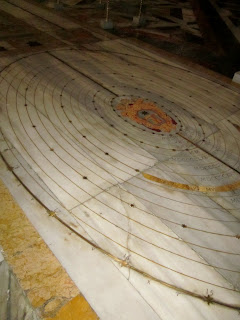 |
| Sphere within a Sphere |
 |
| Ancient bronze pinecone |
The Vatican Museum is incredible. There is an overwhelming amount of stuff to see. One could easily spend a full day here and not actually “see” half of it.
Word of warning to anyone who wants to see the Sistine
Chapel: It is included in the ticket price to the Vatican Museums (15
euro I think? I may be wrong) unless there is severe restoration or my peeps
are electing a new pope. I tried to write down how many times we were hit up
for cash, asked to join a tour, told we could go to the head of the line with
them or some other thing...oh I remember it was "It's a two hour wait in
line for the museums, as a guide we can get you through the line". Perhaps
in summer, however on the day after the day after Christmas we joined a line
that was several blocks long and were in the museum in less than ten minutes.
Caveat: It did take an extra six or seven minutes to go through the metal
detectors etc. No wukkas though, eh?
There are a few items that really did stand out in my memory.
 |
| Octagonal Courtyard |
First the we entered the Pine-Cone Courtyard, which contains, a pine cone...however it is from a 1st century fountain and is made of bronze. It also contains a enormous gilded sculpture called "Sphere Within a Sphere" by Arnaldo Pomodoro.
 |
Gilt Statue Struck by lightning
and buried |
Next off to the side is a little octagonal courtyard that holds some of the most famous
classical sculptures including the Apollo Belvedere, the Laocoon group,
and some incredible sarcophaguses.
 |
| Giant porphyry basin |
Then rooms just filled with so many classical statues and busts that the mid boggleth...
 |
| Statues from Hadrian's Villa |
Then there was the giant porphyry basin (which was just a masterpiece) and in the same room a gilded bronze statue that apparently was struck by lightning and then buried according to Roman custom. The huge sarcophaguses of St. Helena and St. Constantina.
Egyptian style statues from Hadrian’s Villa at Tivoli flank the doors of one of the Greek Cross room, at least I believe that was the Greek Cross Room.
 |
| Ceiling in the Hall of Maps |
The hall of maps was much more incredible than I had expected, and certainly much longer. Also very, very crowded, if one stops for a moment one really begins to feel like a salmon heading upstream.
Not surprisingly picture taking is not allowed in the Sistine Chapel. But it was marvelous to see, especially since the restoration. Again, hard to take in as there were so many people crammed into that room, but I got to see and point out my favorite bits of the last judgement.
Outside, it was a beautiful clear December afternoon, quite warm actually. And perfect to get a nice close up shot of the Dome of St. Peter's.
The double spiral ramp that leads to the street from the museum was built in the 1930's and all I can say is WOW!
 |
| Double Spiral ramp in bronze, exit from Vatican Museum |
|
|
 |
| Dome of St. Peter's from Vatican Museum |




















































